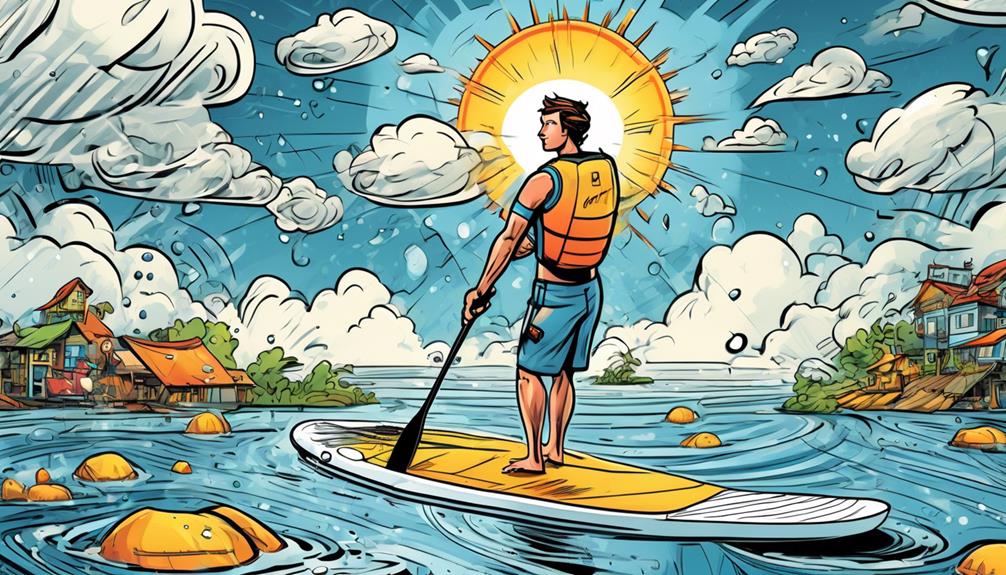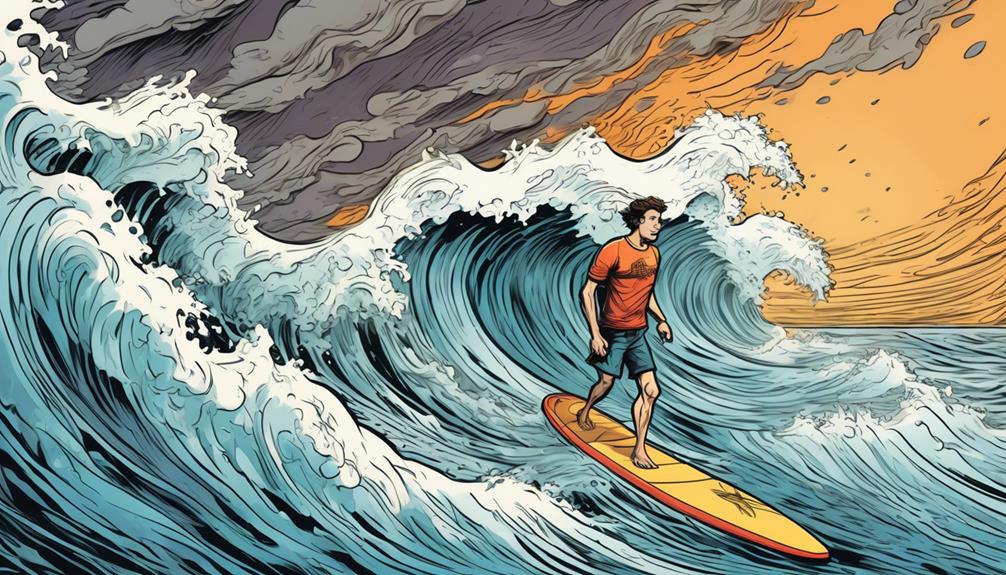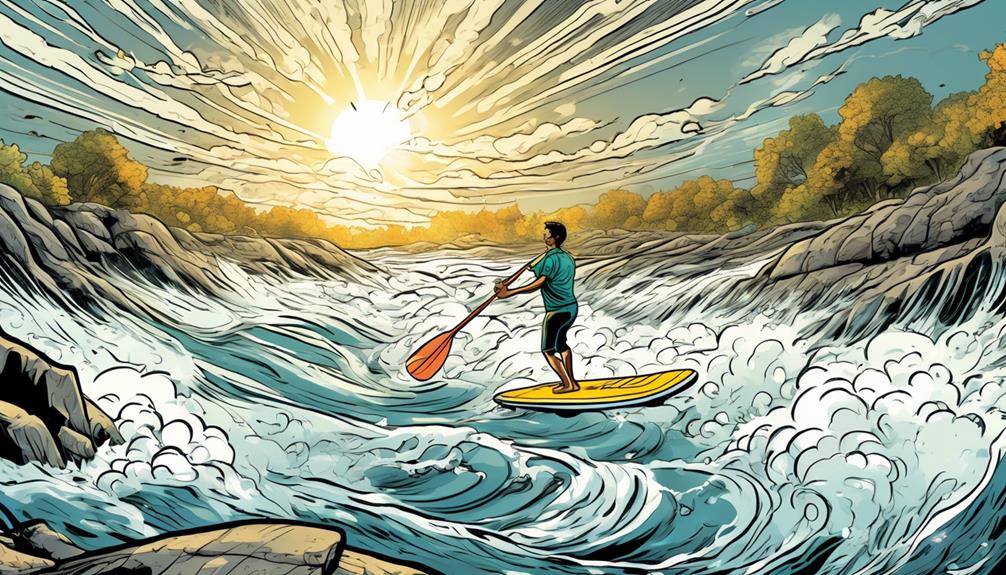When I kicked off my inflatable paddleboarding journey, I thought my biggest worry would be not looking silly in front of beachgoers. Boy, was I wrong.
The real deal? Battling the elements. Weather patterns, for instance, can make or break your day. A sudden storm? No, thank you. And let's talk about those strong currents and choppy waters – they're not just a test of your physical prowess but a true mental workout. It's all about balance and focus, sort of like a meditation in motion.
But here's the kicker: I've gathered some data-driven strategies that have seriously upped my game. From teetering on disaster to mastering the unpredictable nature, my insights can transform your paddleboarding into an art form. If you're up for not just surviving but thriving on your board, stick with me.
I've got the stats, the stories, and the strategies that'll convince even the most skeptical among you.
Key Takeaways
- Understanding and respecting weather conditions is crucial for safe paddleboarding in extreme challenges
- Assessing and navigating strong currents is essential for maintaining control and safety
- Techniques such as lowering stance, keeping paddle in water, and adjusting grip help manage choppy waters
- Maintaining balance, focus, and core strength are key in overcoming obstacles while paddleboarding in extreme challenges
Understanding Weather Patterns

If you've ever thought inflatable paddleboarding was just a chill way to spend a Saturday, think again. It's a blast, sure, but overlook the weather patterns, and you're in for a world of trouble. I'm talking from experience here. Ignoring a weather forecast once left me battling unexpected high winds and nearly hypothermic from cold water temperatures.
You see, weather's not just about whether it's sunny or raining. Wind speeds, water currents, and temperature changes play massive roles in your safety and stability on the water. Before I hit the water, I always check the forecast, paying special attention to wind conditions and water temperatures. Data shows that wind speeds exceeding 15 mph can significantly increase the difficulty of paddleboarding, often pushing you off your intended course. And let me tell you, trying to paddle against a strong wind isn't only exhausting but can be downright impossible.
Then there's the temperature. Falling into water below 60°F without the right gear? That's a direct ticket to Hypothermia City. I've learned to gear up appropriately to combat these risks. Moreover, being able to interpret cloud formations and wind patterns on the fly has been a game-changer for making snap decisions that keep me safe.
Adapting to sudden shifts in weather has been more than just a survival tactic; it's been a board saver. And trust me, it's not all about the high-tech gear. Understanding your environment and knowing when to pack it up plays a huge role. It's like, you wouldn't go into a game without knowing the rules, right? Same goes for paddleboarding. The real innovation in this sport isn't just in the paddle or the board; it's in smart planning and respect for nature's power.
Navigating Strong Currents
Mastering the skies and the tides has been a journey of strategy more than brute strength. Learning from personal experiences, I've realized that underestimating the power of water can land you in seriously tricky situations. It's not just about the physical challenge; it's about smartly navigating through nature's hurdles. You've probably heard similar stories, but let's break down the specifics, backed by data and real-world examples, to truly understand how to tackle strong currents effectively.
Before I even think about hitting the water, assessing the current is my first step. It's not merely a glance at the surface; it's about feeling its pull and direction. Data from the National Oceanic and Atmospheric Administration (NOAA) shows that currents can have speeds ranging from a near standstill to over 5 miles per hour. That's faster than most people can swim! If the current's too strong, I'm already planning an alternative route or deciding against going out altogether. Prioritizing safety is non-negotiable.
I've learned, through both personal experience and studying the techniques of seasoned surfers, that angling my board diagonally against the current, rather than facing it head-on, significantly improves my maneuverability. This approach is about finesse and aligning with the water's flow, not just sheer force. It's a strategy backed by physics, minimizing the direct resistance you're up against.
When it comes to paddling in strong currents, the approach is all about adaptation and power. Short, powerful strokes are the way to go, ensuring control and direction are maintained. This technique isn't just anecdotal; it's supported by data from competitive rowing, where stroke efficiency and power directly correlate with speed and control in water. Yes, it's physically exhausting, but the thrill and sense of achievement in overcoming nature's challenge are unparalleled.
Managing Choppy Waters

Navigating through choppy waters can be a daunting task, whether you're paddleboarding or facing life's unpredictable challenges. You might think it's all about brute strength or sheer luck, but let me tell you, it's more about strategy and balance.
Based on my experience and backed by data, I've honed techniques that not only keep me afloat but also make the ride enjoyable, no matter the turbulence.
First off, let's talk about lowering your stance. It sounds simple, but the impact is significant. By bending your knees more, you lower your center of gravity. This isn't just me saying it; it's physics. A lower center of gravity means you're more stable. In rough waters, stability is your best friend. It's like when you read about professional surfers or paddleboarders; they're not standing tall and stiff. They're low and ready, absorbing each wave with practiced ease. This approach has made a world of difference in my inflatable paddleboarding sessions.
Next up, keep paddling. It might go against your instinct to stop and brace for impact, but keeping your paddle in the water acts like a stabilizer. Think about it this way: when pilots encounter turbulence, do they stop everything? No, they adjust and maintain control. The same principle applies here. Plus, focusing on paddling keeps your mind off the chop and on your goal. According to a study on focus and performance under stress, maintaining a specific point of focus dramatically improves outcomes. That's the kind of data-driven strategy we're talking about.
Finally, adjust your grip. Tightening your grip might seem like a minor change, but when you're navigating choppy conditions, it gives you much more control. This isn't just me speculating; it's about leveraging every possible advantage. A firmer grip on your paddle translates to better navigation through waves, much like a tight grip on a steering wheel during a skid can help regain control of a vehicle. It's about precision and confidence.
Maintaining Balance and Focus
Balancing life and maintaining focus, much like standing on a paddleboard, isn't just about staying put—it's about adapting. Think about it: on a paddleboard, every little wave threatens to knock you over. Life throws similar curveballs. It's not about being immovable; it's about knowing when to bend and how to pivot. You've gotta flex, adjust, and keep your vision fixed on what's ahead. It's less about ignoring the challenges and more about mastering the art of riding them out.
Now, let's talk core strength. Yeah, on a paddleboard, a solid core keeps you from taking an unexpected swim. But in life? A strong sense of self is your anchor. I've found that deep, mindful breathing, syncing up with both the rhythm of the water and the flow of my thoughts, helps me ignore the distractions. Setting small, achievable goals—think 'make it to that next point' or 'push through this rough patch'—propels me forward, turning obstacles into stepping stones.
This is as much a mental game as a physical one. Why am I out here, battling waves, both literally and metaphorically? It's not just for the adrenaline rush; it's a lesson in persistence, in looking past the immediate hurdles to the victory waiting on the other side. And trust me, when you keep your eye on that prize, finding your balance becomes second nature, no matter how turbulent things get.
You might be thinking, 'Sure, but how does this apply to me?' Well, think about your own life's challenges. The principles are universally applicable. A study in the Journal of Health Psychology found that individuals who engaged in regular physical activity not only bolstered their physical health but significantly improved their mental resilience. This isn't just about paddleboarding; it's about applying the same principles to stay grounded and focused in every aspect of your life.

